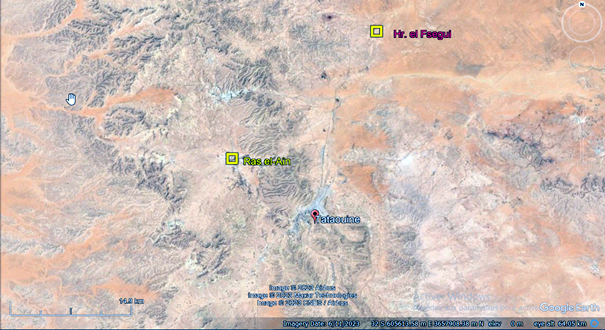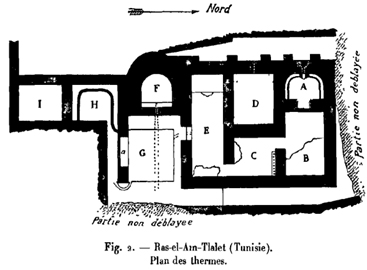
Ras-el-Aïn (Tlalet): A vestige of the Tripolitanian limes
Located on the plain of El Ferdj, at the outlet of the Tlalet valley, Ras-el-Aïn Tlalet is an archaeological site of great historical importance. The modern name "Tlalet" derives from the ancient Roman station Talalati. Discovered in 1894 by Lieutenant Lecoy de la Marche, the site has undergone successive excavations, notably by Lieutenants Goulon (1902), Bouvet (1908), and Captain Boizat (1912).
The main feature of the site is a Roman military camp, described by Pol Trousset as a square enclosure measuring 93 metres on each side, with rounded corners and a monumental gate on each face. Renault, on the other hand, refers to a fortress of approximately 100 metres, which he associates with the ancient name Thebelamni. An inscription engraved on one of the northern gates, dated between 263 and 264 during the reign of Gallienus, attests to the site's strategic role in defending the southern frontier (Limes Tripolitanus).

Among the major discoveries: • Fortified enclosure: square enclosure, rounded at the corners, with a gate on each side • Roman baths: The heating system (hypocaust) remains partially identifiable.

Despite its archaeological significance, the site has been levelled and is now under threat from: 1. Illegal excavations: Leading to the destruction of essential remains. 2. Natural erosion: Gradually degrading the remaining structures. Recent initiatives, such as the "Partnership of Heritage" project, have helped draw attention to the urgent need to protect this unique heritage.
Ras-el-Aïn Tlalet is a valuable testament to Roman military history in southern Tunisia. Its recognition and preservation are essential to passing on this exceptional heritage to future generations.

Ras-el-Aïn Tlalet is a valuable testament to Roman military history in southern Tunisia. Its recognition and preservation are essential to passing on this exceptional heritage to future generations.


